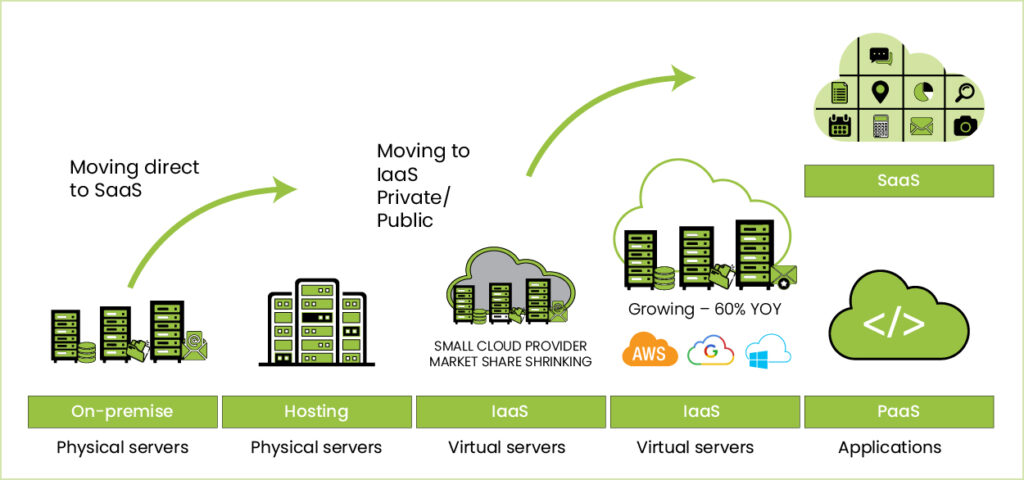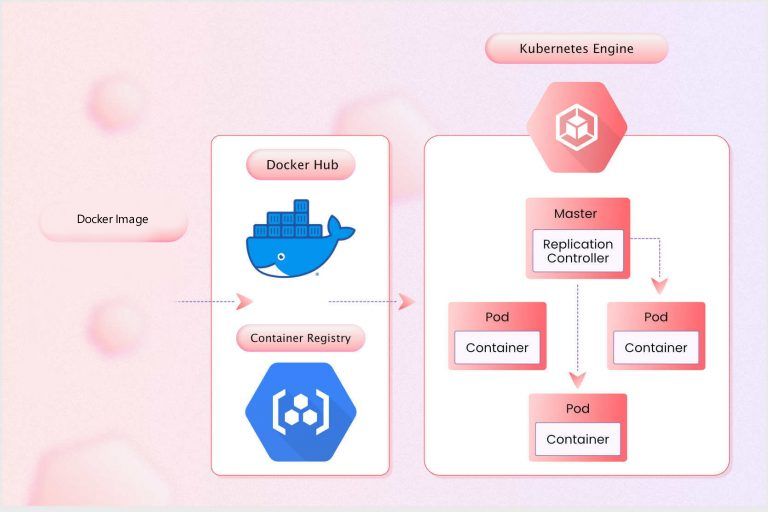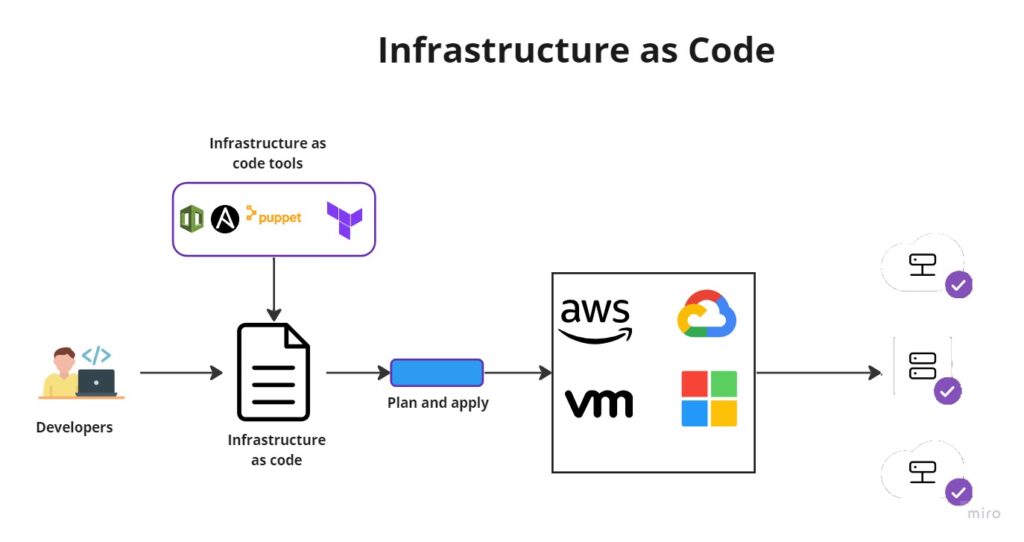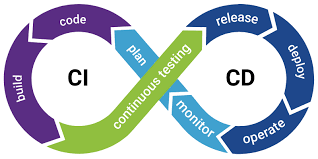- Infrastructure migration services
- Application containerization and orchestration
- Infrastructure as code
- Disaster recovery plans
- Continouse intergration and continous deployment
- Monitoring and alerting
Infrastructure migration services
Infrastructure migration is a complex task that requires careful planning, coordination, and expertise. Our Infrastructure Migration Services provide comprehensive support and guidance to seamlessly migrate your infrastructure while minimizing downtime and disruptions. click here to read more
Application containerization and orchestration
In the era of modern software development and deployment, application containerization and orchestration have become essential for organizations seeking agility, scalability, and efficient resource utilization. Our Application Containerization and Orchestration Services offer comprehensive solutions to containerize your applications, manage container deployments, and optimize orchestration for seamless scalability and management.
Infrastructure as code
Infrastructure as Code (IaC) has emerged as a game-changer, revolutionizing how organizations provision, configure, and manage their infrastructure. Our Infrastructure as Code (IaC) Services offer comprehensive solutions to automate infrastructure provisioning, improve efficiency, and enhance collaboration between development and operations teams.
DISASTER RECOVERY PLANS
A disaster recovery plan (DRP) is a critical component of any business continuity strategy. Disruptions such as natural disasters, cyberattacks, equipment failures, and human errors can significantly impact your business operations, resulting in lost revenue, damage to reputation, and legal liabilities. Our Disaster Recovery Plan Services offer comprehensive solutions to help you minimize the impact of disruptions and quickly recover from unexpected events, ensuring business continuity and customer satisfaction
CONTINOUSE INTERGRATION AND CONTINOUS DEPLOYMENT
Continuous Integration and Continuous Deployment (CI/CD) practices have transformed software development by enabling faster, more efficient, and reliable delivery of applications. Our CI/CD Services offer comprehensive solutions to automate the software development lifecycle, streamline deployment processes, and foster a culture of collaboration and innovation.
MONITORING AND ALERTING
Effective monitoring and alerting are crucial for maintaining the performance, availability, and security of your IT infrastructure and applications. Our Monitoring and Alerting Services provide comprehensive solutions to monitor your systems, collect valuable data, and proactively notify you of critical events, ensuring operational excellence and minimizing downtime
INFRASTRUCTURE MIGRATION SERVICES

In today’s fast-paced technological landscape, businesses often need to migrate their infrastructure to modernize their IT environments, improve scalability, enhance security, or leverage new cloud platforms. Infrastructure migration is a complex task that requires careful planning, coordination, and expertise. Our Infrastructure Migration Services provide comprehensive support and guidance to seamlessly migrate your infrastructure while minimizing downtime and disruptions.
Key Benefits of using our Infrastructure Migration Services:
- Expert Guidance and Planning: Our experienced team of infrastructure experts understands the intricacies of infrastructure migrations. We work closely with your organization to assess your current environment, identify migration goals and requirements, and develop a comprehensive migration plan. Our experts bring industry best practices and proven methodologies to ensure a smooth and successful migration.
- Minimized Downtime and Disruptions: We understand that downtime and disruptions can have a significant impact on your business operations. Our migration services are designed to minimize downtime and ensure a seamless transition. We carefully plan migration schedules, leverage automation tools, and utilize failover and rollback mechanisms to minimize any potential disruptions during the migration process.
- Risk Mitigation and Data Security: Migrating infrastructure involves handling sensitive data and mitigating risks associated with data loss or security breaches. Our team follows strict security protocols and best practices to protect your data throughout the migration process. We employ encryption, secure data transfer methods, and conduct thorough testing to ensure data integrity and maintain compliance with industry regulations.
- Scalability and Flexibility: Infrastructure migrations provide an opportunity to optimize your infrastructure for scalability and flexibility. Our experts assess your current infrastructure architecture and work with you to design a scalable and flexible solution that meets your business needs. We leverage cloud technologies, containerization, and virtualization to ensure your infrastructure is adaptable to future growth and changing requirements.
- Vendor and Platform Expertise: Our Infrastructure Migration Services cover a wide range of platforms, including on-premises, hybrid, and cloud environments. Whether you are migrating to a new data center, transitioning to a cloud service provider, or adopting a multi-cloud strategy, our team has extensive experience and expertise across various platforms and vendors. We ensure a seamless migration, regardless of the complexity or diversity of your infrastructure landscape.
- Post-Migration Support and Optimization: Our services go beyond the migration itself. We provide post-migration support and optimization to ensure your infrastructure operates at peak performance. Our experts monitor and fine-tune the migrated environment, address any post-migration issues, and provide ongoing support to optimize performance, security, and cost-efficiency.
we are using these tools for IAC and configuration management
- Terraform: Terraform is a widely adopted tool for provisioning and managing infrastructure resources across various cloud providers and on-premises environments. It uses a declarative language to define infrastructure as code and supports a wide range of services and platforms.
- AWS CloudFormation: AWS CloudFormation is a service provided by Amazon Web Services (AWS) that allows you to describe and provision a collection of AWS resources using templates. It provides a way to define infrastructure resources as code and supports a broad range of AWS services.
- Ansible: Ansible is an open-source automation tool that can be used for infrastructure provisioning, configuration management, and application deployment. It uses a simple and human-readable language to define tasks, and it supports a wide range of platforms and services.
APPLICATION CONTAINERIZATION AND ORCHESTRATION

In the era of modern software development and deployment, application containerization and orchestration have become essential for organizations seeking agility, scalability, and efficient resource utilization. Our Application Containerization and Orchestration Services offer comprehensive solutions to containerize your applications, manage container deployments, and optimize orchestration for seamless scalability and management.
Key Benefits of using our application Containerization and Orchestration Services:
- Efficient Application Packaging: Our experts leverage containerization technologies such as Docker to package your applications and their dependencies into self-contained units. Containerizing applications ensures consistency across different environments, simplifies deployment, and eliminates compatibility issues. By encapsulating your applications into containers, we enable streamlined and efficient packaging for deployment.
- Scalable and Flexible Deployment: Container orchestration platforms like Kubernetes empower us to efficiently manage the deployment and scaling of your containerized applications. Leveraging Kubernetes, we automate the process of deploying and managing containers across a cluster of machines, ensuring seamless scalability as your application demands grow. Our services enable horizontal scaling, load balancing, and intelligent resource allocation to optimize application performance.
- Enhanced Resource Utilization: Container orchestration optimizes resource allocation, allowing multiple containers to run on shared infrastructure without conflicts. By dynamically adjusting resource allocation based on application demand, we help maximize resource utilization, resulting in cost savings and improved performance. Our experts optimize container deployment strategies to minimize resource waste and ensure efficient utilization of computing resources.
- Fault Tolerance and High Availability: With container orchestration, we implement strategies to ensure fault tolerance and high availability of your applications. By leveraging features like automatic container restarts, health checks, and distributed load balancing, we establish resilient environments that can recover from failures and ensure continuous application availability.
- Simplified Application Lifecycle Management: Our services provide end-to-end management of the application lifecycle, from development to production. We establish CI/CD pipelines integrated with containerization and orchestration frameworks, automating the process of building, testing, and deploying containerized applications. This streamlined approach accelerates the development and deployment cycles while maintaining consistency and quality throughout the application lifecycle.
- Monitoring and Scaling: We incorporate monitoring and logging solutions into the containerized environment, enabling proactive monitoring of application performance, resource utilization, and system health. Our experts leverage Kubernetes scaling capabilities to automatically scale application instances based on predefined metrics such as CPU usage or request throughput, ensuring optimal performance and responsiveness.
INFRASTRUCTURE AS CODE

In the era of cloud computing and agile software development, Infrastructure as Code (IaC) has emerged as a game-changer, revolutionizing how organizations provision, configure, and manage their infrastructure. Our Infrastructure as Code (IaC) Services offer comprehensive solutions to automate infrastructure provisioning, improve efficiency, and enhance collaboration between development and operations teams.
Key Benefits of using our Infrastructure as Code (IaC) Services:
- Automation and Efficiency: Our IaC services enable you to automate the provisioning and management of infrastructure resources. By leveraging tools like Terraform, AWS CloudFormation, or Azure Resource Manager, we define infrastructure configurations in code, allowing for consistent and repeatable deployments. Automation eliminates manual, error-prone processes, accelerates infrastructure provisioning, and improves overall operational efficiency.
- Version Control and Auditing: Infrastructure code is treated as a version-controlled asset. We help you adopt best practices for code management, allowing you to track changes, roll back to previous versions, and conduct audits. This approach brings transparency, accountability, and traceability to infrastructure changes, ensuring compliance requirements are met and facilitating troubleshooting when issues arise.
- Consistency and Reproducibility: IaC ensures infrastructure configurations are consistent across different environments, such as development, testing, staging, and production. By using the same codebase to provision and manage infrastructure, we eliminate configuration drift and reduce the “works on my machine” problem. Consistency improves reliability, reduces errors, and enables reproducibility across various environments.
- Collaboration and DevOps Culture: IaC fosters collaboration between development and operations teams, promoting a DevOps culture. Infrastructure code serves as a shared language, allowing developers and operations personnel to collaborate, review, and contribute to infrastructure configurations. This collaboration enhances communication, breaks down silos, and aligns the entire team towards shared goals.
- Scalability and Flexibility: IaC allows for flexible and scalable infrastructure deployments. We design infrastructure code to be modular and reusable, enabling you to scale resources up or down as per your application needs. Whether you’re scaling vertically or horizontally, our IaC services ensure your infrastructure can efficiently handle increased workloads and adapt to changing business requirements.
- Cloud-Agnostic Approach: Our IaC services support various cloud platforms, such as AWS, Azure, Google Cloud, and others. We help you leverage the power of cloud computing by defining infrastructure resources and configurations that are portable across multiple cloud providers. This flexibility allows you to adopt a multi-cloud strategy or migrate between cloud platforms without vendor lock-in.
DISASTER RECOVERY PLANS

A disaster recovery plan (DRP) is a critical component of any business continuity strategy. Disruptions such as natural disasters, cyberattacks, equipment failures, and human errors can significantly impact your business operations, resulting in lost revenue, damage to reputation, and legal liabilities. Our Disaster Recovery Plan Services offer comprehensive solutions to help you minimize the impact of disruptions and quickly recover from unexpected events, ensuring business continuity and customer satisfaction.
Key Benefits of using our Disaster Recovery Plan Services:
- Risk Assessment and Business Impact Analysis: Our DRP services start with a thorough analysis of your business processes, systems, and infrastructure to identify potential risks and assess the impact of disruptions. We work with your team to evaluate critical business functions, recovery time objectives (RTOs), recovery point objectives (RPOs), and dependencies to develop a customized DRP that aligns with your business goals and requirements.
- Robust Disaster Recovery Strategies: Our experts develop and implement comprehensive disaster recovery strategies to ensure minimal downtime and data loss. We design recovery plans that cover all critical components of your IT environment, including servers, databases, applications, and network infrastructure. We use industry best practices to set up redundant systems, backup and restore procedures, and failover mechanisms to provide high availability and seamless business continuity.
- Regular Testing and Maintenance: A DRP is only effective if it is tested and updated regularly. Our DRP services include regular testing and maintenance to ensure that your recovery plans remain effective and up-to-date. We simulate various disaster scenarios to evaluate the effectiveness of your recovery plans, identify gaps and vulnerabilities, and make necessary adjustments. We also perform routine maintenance tasks such as backups, patches, and software upgrades to keep your systems secure and reliable.
- Cost-Effective Solutions: Our DRP services provide cost-effective solutions that minimize the impact of disruptions while keeping your budget in check. We work with your team to determine the most cost-effective recovery strategies that align with your budget and business goals. We also leverage cloud-based solutions and virtualization technologies to provide flexible and scalable disaster recovery options that reduce hardware and maintenance costs.
- Compliance and Regulatory Requirements: Our DRP services ensure that your recovery plans comply with regulatory requirements and industry standards. We work with your team to identify and address compliance issues related to data privacy, security, and regulatory requirements. Our services include developing policies and procedures that meet legal and regulatory requirements and conducting audits to ensure that your recovery plans comply with established standards.
CONTINOUSE INTERGRATION AND CONTINOUS DEPLOYMENT

Continuous Integration and Continuous Deployment (CI/CD) practices have transformed software development by enabling faster, more efficient, and reliable delivery of applications. Our CI/CD Services offer comprehensive solutions to automate the software development lifecycle, streamline deployment processes, and foster a culture of collaboration and innovation.
Key Benefits of using our CI/CD Services:
- Automated Build and Test Processes: Our CI/CD services automate the build, testing, and quality assurance processes of your software development lifecycle. By integrating tools like Jenkins, GitLab CI/CD, or CircleCI, we configure pipelines that automatically build, test, and validate your application code. Automated processes reduce manual errors, ensure code consistency, and accelerate time-to-market.
- Continuous Integration for Collaborative Development: CI promotes collaboration among development teams by integrating code changes regularly and frequently. We help you establish development workflows and version control practices that encourage developers to commit their code frequently to a shared repository. By continuously integrating code changes, we identify and resolve conflicts early, fostering a collaborative development environment.
- Efficient Code Reviews and Quality Assurance: Our CI/CD services incorporate code review and quality assurance processes into your software development lifecycle. We configure code review tools and define coding standards to ensure code quality. Automated testing frameworks, such as unit tests, integration tests, and acceptance tests, are integrated into the CI/CD pipeline, enabling rapid and reliable validation of code changes.
- Automated Deployment and Release Management: Our CI/CD services enable seamless and automated deployment of your applications. We help you define deployment strategies, such as rolling deployments or blue-green deployments, to minimize downtime and ensure smooth releases. By automating deployment processes, we reduce the risk of errors, enable faster release cycles, and provide consistent and reliable application deployments.
- Infrastructure as Code Integration: We integrate Infrastructure as Code (IaC) practices into your CI/CD pipelines, allowing for consistent and automated provisioning of infrastructure resources. By leveraging tools like Terraform or AWS CloudFormation, we define infrastructure configurations as code, enabling the automatic creation and management of required resources during deployment. This integration ensures consistency between development, testing, and production environments.
- Continuous Monitoring and Feedback: Our CI/CD services include the integration of monitoring and feedback mechanisms to provide continuous insights into application performance and user feedback. We configure monitoring tools to collect metrics and log data, enabling proactive detection of issues and performance bottlenecks. User feedback mechanisms, such as user acceptance testing or feedback loops, are incorporated to gather insights and improve the user experience.
MONITORING AND ALERTING

Effective monitoring and alerting are crucial for maintaining the performance, availability, and security of your IT infrastructure and applications. Our Monitoring and Alerting Services provide comprehensive solutions to monitor your systems, collect valuable data, and proactively notify you of critical events, ensuring operational excellence and minimizing downtime.
Key Benefits of using monitoring and Alerting Services:
- Real-Time Visibility: Our monitoring services offer real-time visibility into the health and performance of your infrastructure and applications. We configure monitoring tools to collect and analyze metrics such as CPU usage, memory utilization, network traffic, response times, and more. This real-time visibility allows you to quickly identify and address issues before they impact your business operations.
- Proactive Issue Detection: Our alerting services ensure that you receive timely notifications when critical events or anomalies occur. By setting up thresholds and alerting rules, we proactively detect and alert you to potential issues. This proactive approach allows you to take immediate action, minimizing downtime and preventing costly disruptions to your business.
- Customizable Monitoring Dashboards: We create customizable dashboards that provide a consolidated view of your system’s health and performance. These visual representations enable you to monitor key metrics, track trends, and gain actionable insights. By tailoring the dashboards to your specific needs, you can focus on the most critical aspects of your infrastructure and applications.
- Incident Response and Troubleshooting: When incidents occur, our monitoring and alerting services facilitate incident response and troubleshooting. Detailed alerts provide essential information about the nature and severity of incidents, enabling your team to quickly diagnose and resolve issues. This streamlined incident response process reduces mean time to resolution (MTTR) and minimizes the impact on your business.
- Performance Optimization: Monitoring and alerting services help you identify performance bottlenecks and optimize your systems. By analyzing historical data and trends, we gain insights into the performance of your infrastructure and applications. We provide recommendations for optimization, scalability improvements, and resource allocation adjustments to ensure optimal performance and user experience.
- Compliance and Reporting: Our monitoring services assist in meeting compliance requirements by capturing and analyzing data relevant to regulatory standards. We generate compliance reports that provide evidence of adherence to industry regulations and best practices. These reports support audit processes and demonstrate your commitment to data security and regulatory compliance.
